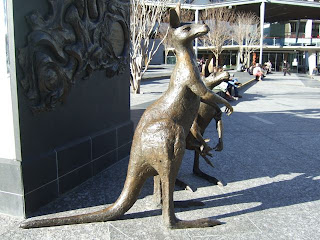Every four years the geologists from around the world get
together in an International Geological Congress (IGC) which was held
this year in Brisbane Australia. It's a long haul from the UK, but it's increasingly necessary to be present outside of Europe and North America as we
start to see real globalisation of our science.
 |
| Entrance to the IGC at the Brisbane Convention and Exhibition Centre |
Increasingly science research programmes that were
dominated by western subscriptions are being joined by memberships from Brazil,
China and India. We are starting to see significant investments in geological
research in these and other countries, not only to underpin their natural
resources, but also to educate their young scientists. One notable movement is
the Young Earth Scientists (YES) network that will be meeting with the IGC.
YES focus on up to date media such as webinars, blogs and social media to
communicate; the formal lecture being slower and reaching fewer
scientists.
IGC on reducing carbon emissions
A significant focus of the IGC meeting in Brisbane was on
energy supply and security. How can we reduce our dependence on carbon as coal,
oil and gas, for energy? These sources of energy are very efficient. They have high calorific values and are relatively easy
to transport, but 30 billion tonnes of carbon per year are injected into the
atmosphere and have resulted in an increase in global carbon dioxide (CO2) in the
atmosphere from 280 ppm to nearly 400 ppm since the industrial revolution.
Over the same period the population of the planet has
grown to 7 billion. Expected demand for energy as this population grows and
demands better living standards, will at the very minimum double to 1000
exajoules per year. We must reduce emissions.
Coal burning produces about
twice the CO2 output of gas power stations and a significant part of the
reduction could then come from conversion to gas power plants that are fed from
potential gas reserves held tightly in sediments, called shale gas; the USA
uses 200 trillion cubic meters of gas per year and now more than half comes
from shale gas. There is a consensus among geologists that shale gas is a
potential resource that will significantly extend our dependence on carbon
related energy, but at the same time we must make energy use efficiencies and
use non carbon sources from energy, including nuclear, geothermal, solar and
wind production. Australia plan to include a significant geothermal part in
their energy mix, currently they do not produce any energy this way.
Geological surveys will play an important role in
defining shale gas reserves, geothermal sources, radioactive waste repositories, subsurface energy storage and infrastructure for wind-farms. Transparency
and publication of operational practices and research results is mandatory.
Very dynamic geology in New Zealand
After my visit to Brisbane, I am now in New Zealand at
GNS Science having discussions on the International Continental Drilling Project (ICDP). This is the most active geological environment on Earth
as New Zealand sits astride the Alpine fault which cuts across the country dividing the
Australian plate from the Pacific plate. The collision between the two is at
about 5 cm a year year (50 meters in a thousand years) and the mountains are
created by uplift and erosion with 12 meters rainfall on west side of alpine fault
and as low as 30 cm the other side resulting in a sharp contrast in relief, erosion and vegetation West to East across the country.
It is an earthquake prone region and the recent
Christchurch earthquake although not as large as some earthquakes, has resulted in significant damage, a large part of the
city will have to be abandoned and relocated. This damage was mostly due to a process
called liquefaction, which liquidises the shallow sediments as a result of
shaking of water saturated sediments. This is why a detailed understanding of
the shallow subsurface and how it behaves in earthquakes is needed to better
manage the risk of damage.

Hello,
ReplyDeleteThis is a very beautiful blog and very nice blog post.. we want come back on this blog.... Thanks
I'm telling everyone about this referencing your post tomorrow. You can't make this stuff up! - Good spotting!
ReplyDeletehttp://www.surveytool.com/training-survey/
Excellent Post,
ReplyDeleteI agree with this nice post on International Geological Congress (IGC). Thanks for sharing this Information
A survey method is a data collection tool used to gather information by asking questions to people. Look for additional posts on this topic soon. Thanks for sharing this info.
ReplyDeleteClient Surveys